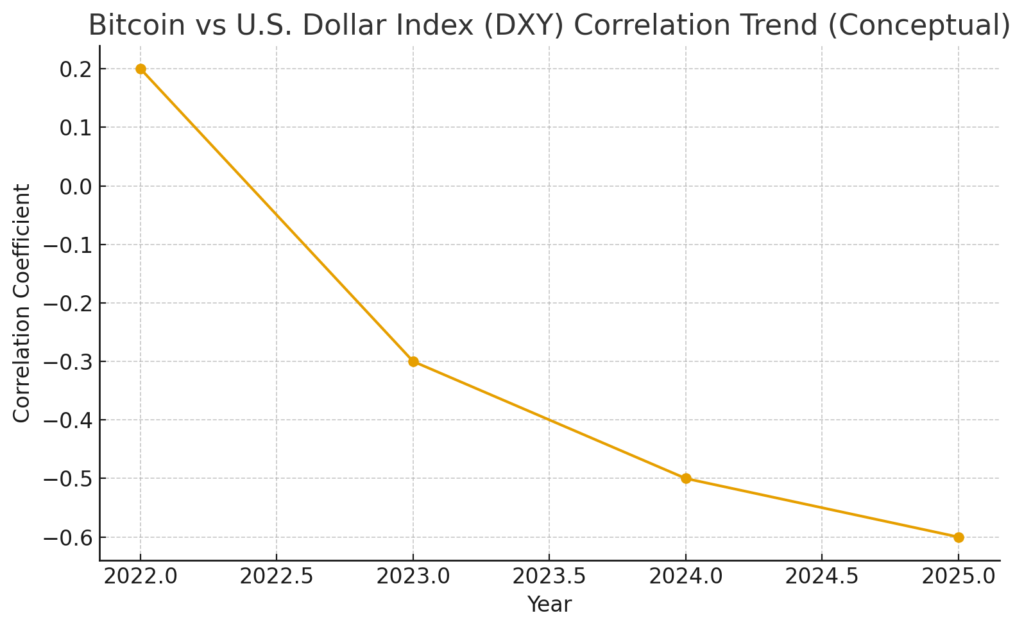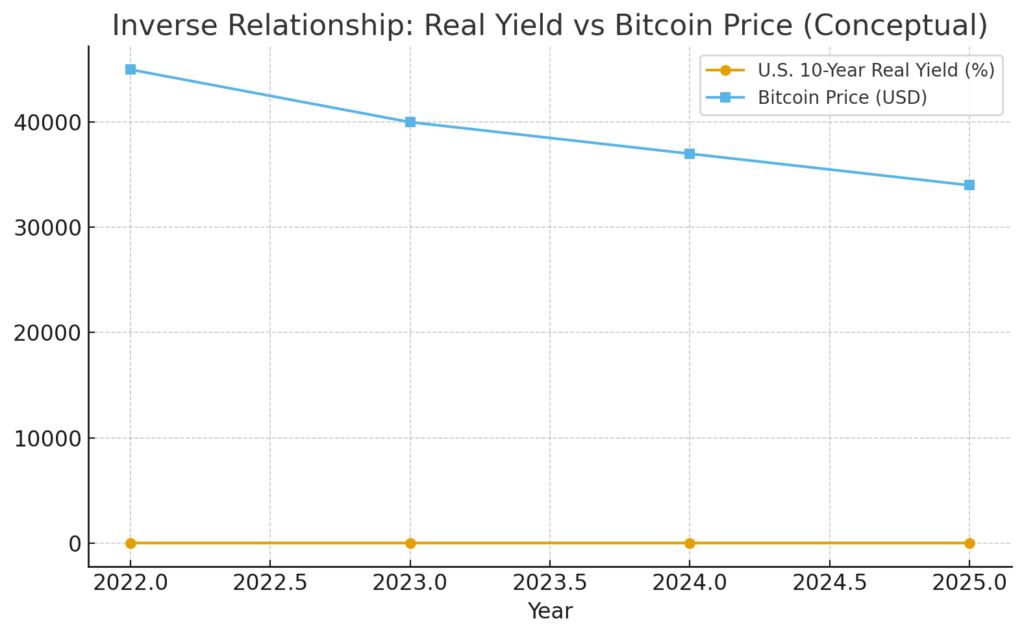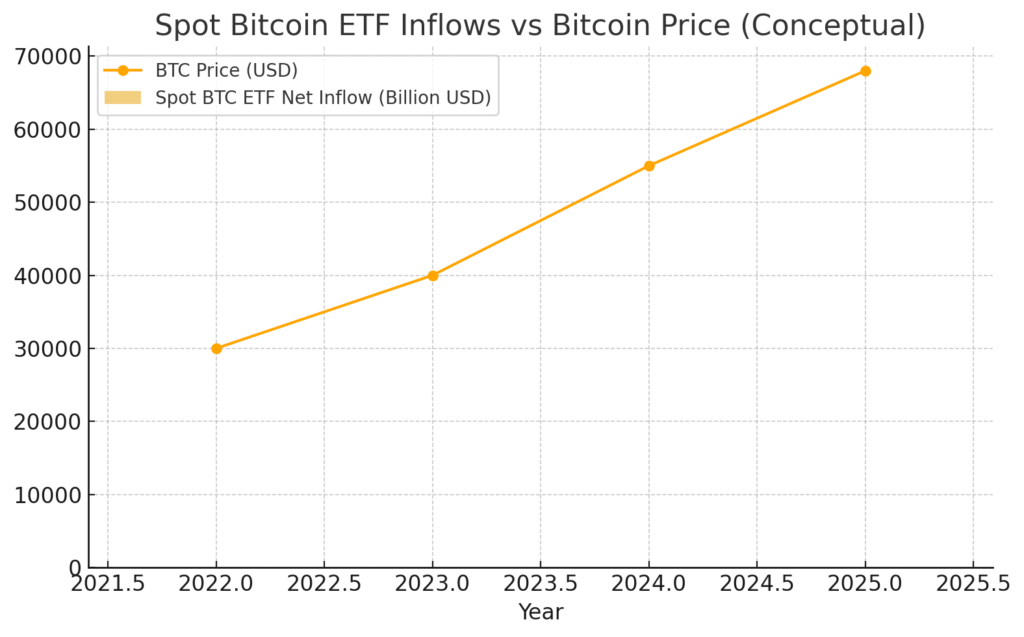
Main Points :

- Bitcoin’s price movements are increasingly tied to the U.S. dollar index (DXY) and real interest rates, rather than simply inflation.
- The rise of physical spot Bitcoin ETFs has created a direct feedback loop between macroeconomic signals (dollar strength, real yields) and institutional flows.
- Key indicators for assessing Bitcoin’s near-term prospects: the DXY trend, 10-year real yields, and daily/weekly net flows into spot Bitcoin ETFs.
- For blockchain practitioners and crypto investors, this means Bitcoin is behaving more like a high-beta risk asset than a pure “store of value” inflation hedge.
- Strategy implications: monitor liquidity and macro dynamics rather than just inflation prints; treat Bitcoin as part of an institutional flow-driven ecosystem.
1. Shifting Narrative: From Inflation Hedge to Dollar / Yield Sensitivity
Historically, the narrative around Bitcoin (BTC) emphasized its role as “digital gold” — a store of value that would protect against inflation. Recent analysis suggests that while that story is not entirely wrong, it no longer captures the dominant market dynamic. Multiple sources note that Bitcoin’s correlation with consumer price inflation prints has weakened, while its inverse correlation with the U.S. dollar index (DXY) and real yields has grown.
For example, when the dollar weakens and real yields fall, Bitcoin tends to rally — and conversely, when the dollar strengthens and yields rise, BTC price tends to suffer. One commentary observes:
“Bitcoin no longer moves mainly on CPI prints… The key driver is liquidity and the U.S. dollar.”
Another shows that the weekly regression of Bitcoin returns indicates about one-third of variance is explained by changes in DXY, real yields (e.g., 10-year Treasury inflation-protected securities yield), and ETF flows.
The takeaway: BTC now functions more like a dollar and real-yield beta than a pure inflation hedge.
2. Why Dollar Strength & Real Yields Matter

There are mechanics behind this shift. The logic goes roughly as follows:
- The U.S. dollar’s strength (via DXY) reflects global dollar liquidity. A strong dollar tightens dollar-based funding and dampens cross-border risk appetite. When DXY rises, global liquidity tends to compress, which is unfavourable for risk assets including BTC.
- Real yields (interest rates minus inflation expectations) represent the opportunity cost of holding non-yielding assets like Bitcoin. When real yields are high, cash and short-term Treasuries compete with Bitcoin for capital; when real yields fall, holding Bitcoin becomes relatively more attractive.
- Institutional allocation decisions integrate these dynamics: when liquidity improves (dollar weakens / real yields decline), institutions may rotate into risk assets and Bitcoin specifically, increasing demand. Conversely, tighter conditions lead to outflows and risk aversion.
Hence, the interplay of dollar strength, real yields, and institutional flows creates a tighter, more predictable relationship with Bitcoin’s price than mere inflation anxiety.
3. The Amplifier: Spot Bitcoin ETFs & Institutional Adoption

Another significant development is the rise of physical spot Bitcoin ETFs (e.g., in the U.S.). These vehicles have introduced a transparent channel for institutional capital to flow into BTC markets, and thereby the macro-signals above now feed directly into crypto demand. One study observes the introduction of U.S. spot Bitcoin ETFs reduced volatility of older vehicles and changed return dynamics.
For example, a recent article noted that weeks with large ETF creations (net inflows) typically coincide with DXY falling or real yields rolling over. Creations pull new coins into the market, increasing spot demand; redemptions do the opposite.
This institutional infrastructure means macroeconomic signals quickly filter into the crypto market via regulated financial intermediaries, magnifying the responsiveness of Bitcoin to macro conditions.
4. What This Means for Crypto Investors & Blockchain Practitioners
For your audience—those seeking new crypto assets, revenue streams, and real-world blockchain applications—this shift implies several practical adjustments:
Sub-heading: Re-thinking Bitcoin’s Portfolio Role
Rather than simply thinking of Bitcoin as an inflation hedge, it’s more appropriate to treat it as a high-beta risk asset tied to macro liquidity. That means:
- In times of improving liquidity (dollar weakness, easing real yields), BTC may rally strongly.
- In times of tight liquidity (dollar strength, rising real yields), BTC may decline even if inflation is high.
- Diversification benefits may shift: Bitcoin is less of a “safe haven” and more of a speculative growth/institutional allocation.
Sub-heading: Indicators That Matter
Rather than tracking only CPI prints, you should focus on:
- The U.S. Dollar Index (DXY) trend: sustained weakness tends to favour Bitcoin.
- Real yields (10-year TIPS yield, 10-year–2-year real yield spread): declines in these suggest improved Bitcoin carry.
- Net flows into spot Bitcoin ETFs (daily/weekly): sustained inflows signal strong institutional demand.
- Macro policy pivot events (e.g., Federal Reserve (Fed) meetings, fiscal announcements): because these tend to shift expectations of liquidity.
For instance, one projection suggests that under a base case of gradual disinflation, the policy rate might land in the 2.75 %–3.25 % range by October 2026, real yields may drift lower, and Bitcoin could benefit. Conversely, sticky inflation and a firm dollar could trap Bitcoin in range-bound behaviour.
Sub-heading: Implications for Blockchain Projects & Altcoins
While the article specifically discusses Bitcoin, the macro dynamics have broader implications for blockchain and crypto asset strategies:
- Projects built on non-yielding native assets may suffer when real yields rise, as opportunity cost increases.
- Blockchain utility plays and yield-generating assets may outperform in higher-yield regimes.
- Institutional demand via ETFs or regulated investment vehicles can spill over into altcoins indirectly—as Bitcoin becomes the gateway, liquidity may eventually rotate outward.
- For wallet/services developers (as you are building a non-custodial wallet with swap features), understanding that Bitcoin’s drivers are shifting matters for UX and messaging: rather than “store of value against inflation” you may frame Bitcoin as “macro liquidity barometer” and position your platform accordingly.
5. Strategy and Risk Considerations
Given the above, some strategic considerations emerge:
- Entry/timing: It may make sense to increase exposure when the dollar is in a clear down-trend, real yields are peaking and declining, and ETF flows turn positive.
- Risk sizing: Keep position sizes modest given volatility and regime shifts. The earlier narrative of Bitcoin as uncorrelated is no longer valid — the correlation with equities and macro-assets has increased.
- Rebalance: In portfolio architecture, Bitcoin now behaves more like a growth/higher-risk component rather than pure inflation hedging — rebalance accordingly.
- Scenario planning:
- Bull case: Real yields fall by 25–50 bps, dollar weakens, ETF inflows accelerate past $1 billion weekly → Bitcoin rallies.
- Base case: Slow disinflation, modest real yield decline, dollar drifts lower → Bitcoin modestly positive.
- Bear case: Real yields rise, dollar strengthens, ETF flows stall → Bitcoin suffers.
- For blockchain/altcoin strategy: Be mindful that Bitcoin sets the macro tone. If you expect a macro-liquidity expansion, layer in projects that benefit from risk-on flows; if you expect tight liquidity, focus on yield-generating, utility-rich protocols rather than pure narrative plays.
Conclusion
In summary, the role of Bitcoin is evolving. It’s no longer enough to say “Bitcoin protects you from inflation.” The evidence suggests that Bitcoin now behaves far more as a barometer of dollar liquidity and real interest-rate regimes, amplified by institutional flows through spot ETFs. For crypto investors looking for the next revenue streams or blockchain real-world applications, this imposes a shift in mindset: treat Bitcoin (and by extension major crypto assets) as part of the macro-liquidity ecosystem, rather than isolated digital scarcity plays. Track the dollar index, real yields, and ETF flows. Position accordingly. For wallet-builders and service-providers like your non-custodial platform, framing Bitcoin and other tokens within this macro context may deepen user understanding and engage institutional as well as retail clients. Ultimately, staying ahead in crypto means not only following blockchain innovation but also blending in macro-financial fluency.

